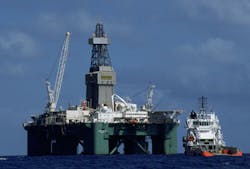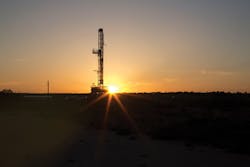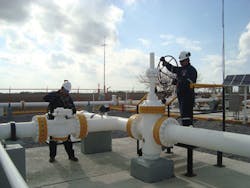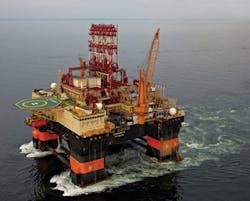Repsol increasing its presence in the deepwater Gulf of Mexico
The Norwegian semi-submersible deepwater platform, leased by Repsol for drilling offshore Cuba.All photos courtesy of Repsol
Repsol currently has an interest in 116 Outer Continental Shelf (OCS) blocks and is the operator, majority owner, and controlling partner in 70 of these blocks.
Over the past six years, Repsol has significantly increased its presence in the deepwater Gulf of Mexico as part of its strategic shift to diversify into countries with membership in the Organization for Economic Co-operation and Development (OECD).
Within the Gulf of Mexico, Repsol's major development projects include the Shenzi field (G-104 and 8), one of the largest deepwater discoveries made to date in the Gulf of Mexico. The field is located 104 miles south of Fourchon, Louisiana, on Green Canyon Blocks 609, 610, 653, and 654, with successful inorganic growth already in production, and in which Repsol has a 28% stake. (BHP Billiton operates the consortium, with a 44% stake, and Hess Corporation owns the remaining 28%.) Shenzi is located at a water depth of 4,300 feet, and lies in the Western Atwater Fold Belt area on the geological trend where the Neptune fields were discovered.
Production of the Shenzi Tension Leg platform field began in March 2009 from a platform located in the Green Canyon 653 block with production from 14 wells connected to the platform. Additional development wells are being drilled at this time and the field is expected to maintain an annual production rate of between 100,000 and 200,000 barrels of oil equivalent per day over the next three years. The Shenzi field holds estimated recoverable reserves of between 300 million and 650 million barrels of oil equivalent.
A second major project for Repsol in the US Gulf of Mexico is the ongoing appraisal of the Buckskin discovery. In 2009, Repsol, in partnership with Chevron, Samson Offshore Company, and Maersk, successfully drilled the ultra-deepwater Buckskin discovery well, located in Keathley Canyon, approximately 186 miles south of Houston. Drilling was suspended in 2010 as a consequence of the Deepwater Horizon accident, and recommenced in May 2011, when operator Chevron received a drilling permit from the Bureau of Ocean Energy Management, Regulation and Enforcement (BOEMRE).
Repsol deepwater platform in Pão de Açúcar, offshore Brazil.
The exploratory well is one of the deepest oil wells drilled to date in the US Gulf of Mexico and the deepest operated by Repsol: at a water depth of 6,500 feet, a total depth to reservoir of 29,404 feet and penetrating over 300 feet of oil saturated rocks in Lower Tertiary aged reservoirs. A successful appraisal well was drilled in 2011 and another well is planned for 2012 to continue delineation of this particular field and to determine the extent and commercial viability of hydrocarbon discoveries. Oil production of the Buckskin well is estimated for 2018.
Further interests
Repsol continues to explore for high-impact, rich oil opportunities in the deepwater Gulf of Mexico. The company currently has an interest in 116 Outer Continental Shelf (OCS) blocks and is the operator, majority owner, and controlling partner in 70 of these blocks.
Each OCS block covers approximately 9 square miles (23.3 sq km) and Repsol's exploratory project areas are located in water depths ranging from approximately 770 feet to over 6,750 feet. Companies partnering with Repsol in these projects include Chevron, BHP Billiton, Ecopetrol, Maersk, Samson Offshore Company, Marathon Oil Company, Newfield, and Statoil.
Indeed these projects, among several other similarly productive fields, made 2009 the most productive year for oil and gas activity in the Gulf of Mexico. A stagnation in hydrocarbon reserves in the shallow waters of the shelf means the era of "easy oil" is gone. It is the deepwater areas that are now considered the most profitable and allow the region to continue to deliver material projects for oil and gas majors worldwide.
Repsol aims to add to its successes in the Gulf of Mexico with continued drilling in the next few months. It is estimated that two partner operated exploration wells will begin drilling in 2012 followed shortly after by a Repsol operated drilling campaign, expected to begin in 2013. Repsol is currently completing engineering design studies and permitting work for these planned wells. Two of these exploratory wells will target the Lower Tertiary age reservoirs equivalent to the oil bearing zones found at Buckskin and the third well will target the Miocene aged reservoirs in the Shenzi field.
Exploratory drilling will also continue in the North Cuba Basin, on the Jagüey exploration well, from the Scarebeo 9 platform, following an agreement signed with Saigpem to lease the platform in January 2010.
Seismic imaging
For its oil exploration activities in the deepwater Gulf, a region known for its complex geological structures that make oil and gas exploration and production difficult, Repsol needed to augment its seismic imaging capabilities in order to shorten the time to first oil and reduce the risk of drilling dry holes − whose costs can exceed $175 million − thus ensuring a steady cash flow. Here, Repsol is exploring for rich new oil reserves beneath thick masses of salt which can often require drilling in significant water depths, sometimes through as much as 17,000 feet of salt to reach targets below 30,000 feet. These extreme water depths coupled with high subsurface temperatures and pressures can, and often do, present unexpected drilling complications.
In its deepwater exploration program, Repsol has had to adequately identify and map complex geological structures hidden below the oil bearing sands. While these thick masses of salt create the optimal environment for trapping large oil deposits, their complex, crystalline structure make it difficult to process complex seismic imaging data – the primary tool needed to assess potential hydrocarbon accumulations. Proper acquisition, processing, and interpretation of this data are required to identify potential oil deposits before the drilling of any exploratory well is begun at a cost of between $175 million and $200 million.
Technicians at work on the oil pipelines of the Shenzi Tension Leg Platform.
In 2007, Repsol developed its exploration model and introduced the Kaleidoscope Project – an extremely advanced algorithmic computing infrastructure, developed in partnership with IBM, 3DGeo, Stanford University, and the Barcelona Supercomputing Center. Repsol's Gulf of Mexico exploration team uses state-of-the-art seismic methods and is supported by a highly skilled geophysical technology team consisting of specialists in seismic acquisition and processing.
Other deepwater projects
Repsol has recently enjoyed exploration success in several deepwater basins around the world. The most recent, in partnership with Sinopec, was the Pão de Açúcar well in the Campos basin, offshore Brazil, which showed two accumulations of hydrocarbons with a total thickness of 1,640 feet, one of the densest wells found to date in Brazil. This discovery adds to Repsol's and Sinopec's existing exploration rights in the Santos and Espirito basins offshore Brazil − one of the world's fastest-growing areas of oil and gas reserves.
The areas of Ghana, Angola, and Sierra Leone in West Africa have also produced encouraging results. In February 2012 the Jupiter-1 well in Sierra Leone was drilled in an area that until now, has been largely unexplored, and which follows the discoveries in the area of the Venus B-1 well, drilled by Repsol and Tullow in 2009, and the Mercury-1 well, drilled in 2010. Deepwater exploration and production in the Gulf of Mexico will remain a critical component to Repsol's growth strategy throughout 2012 and it is hoped that this acreage, led by future exploration success, will position the company for long-term growth.
Oil drilling commences in Cuba
Cuba's waters have long been virgin territory for oil and gas exploration and production. However, as of today this is no longer the case. Spain's Repsol has begun drilling in Cuban waters just 70 miles from Florida, and there is considerable concern from state officials who worry about the impact an oil spill would have on the tourism industry. A well blowout in Cuban waters could send crude to beaches in Florida and as far north as South Carolina.
For its part, Repsol says its commitment to offshore drilling in Cuba, the Gulf of Mexico, and throughout the world will be accompanied by the most demanding practices in environmental protection and safety. The company's experience and track record to date would seem to back up its assurances.
However, officials with the US Coast Guard and other federal agencies are particularly concerned about drilling in Cuba because US sanctions against that nation prohibit US companies from drilling in Cuba, supplying equipment or effecting safety regulations in Cuba, or even responding to an oil spill in its waters.
The Scarabeo 9 platform, leased by Repsol for drilling offshore Cuba.
US Coast Guard Capt. Melissa Bert, a visiting fellow at the Council on Foreign Relations, told the Miami Herald recently that the United States needs to find a way to work through sanction hurdles. The US is the best and closest source for remotely operated submersibles and undersea containment technologies, she said. No US companies are currently authorized to cap wells or conduct relief drilling in Cuban waters. Bert urges the government to issue an export-only industry-wide general license for oil spill response in Cuba's waters now rather than in the midst of a crisis.
The US was authorized to inspect the Chinese-built Scarabeo-9 mobile offshore drilling unit (MODU), which is under contract to Repsol, as it was en route to Cuba, but this is not enough, said Bert. She noted that the Deepwater Horizon incident occurred despite well-exercised and coordinated response plans and that ignoring the drilling risks in Cuba could result in an even greater environmental disaster.
Repsol says its commitment to deepwater will be accompanied by the most demanding of practices in environmental protection and safety, which is particularly ensuring to state officials in Florida and those involved in the tourism industry there who are concerned that a blowout and spill could occur in Cuban waters and have implications on that US state. In Brazil, that country recently filed criminal charges against 17 officials from Chevron and Transocean over an oil leak in the Atlantic Ocean, off the Brazilian coast. With that in mind, throughout 2012, Repsol says it will maintain and reinforce its commitment to safely exploring evermore challenging environments in offshore Brazil, West Africa, and the Gulf of Mexico.
In order to meet these challenges, Repsol is continuing to develop advanced technology applicable to hydrocarbon exploration, allowing a faster time to market for new oil and gas properties, by shortening the seismic data analysis phase. In September 2011, Repsol together with the Barcelona Super Computing Center announced the opening of a new research center in Spain. The new center will allow Repsol's research and technology team to develop pioneering projects in areas such as deposit modeling and subsoil fluids monitoring.
The Gulf of Mexico's large reserve potential has justified the significant investment and exploration risk undertaken by Repsol over the past 6 years. Indeed, the oil and gas industry worldwide has seen a significant westward shift, from its geographical focus on OPEC nations to an increased investment in OECD nations.
However, it is the US Gulf of Mexico that continues to set the pace in the development of ultra-deepwater exploration and production. Notwithstanding the technical risks inherent in deepwater activity, it is the region's stable fiscal regime, proximity to markets, and availability of local technology and services that have encouraged oil and gas majors worldwide to reallocate their resources and drill for oil in its ever deeper waters.
More Oil & Gas Financial Journal Archives Issue Articles
View Oil and Gas Articles on PennEnergy.com





